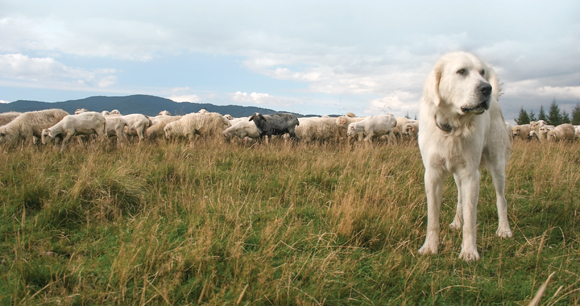BarkLight Collars on Guard Dogs Could Help Protect Livestock
Gray wolf expansion into previously occupied habitat is among the most ecologically successful but socially controversial wildlife restoration efforts undertaken in the western United States. Conflicts between wolves and humans arising from livestock depredation have resulted in the killing of thousands of wolves and continue to undermine species recovery. More than 100 studies indicate that nonlethal methods of deterring carnivores from livestock are as effective as or superior to lethal control. Nonlethal methods have the added advantage of supporting human–wildlife coexistence, through enabling ranchers and wolves to share landscapes and ecosystem benefits, including top predator regulation of ecosystem processes. Adaptive and proactive nonlethal predator deterrents are more sustainable and ecologically beneficial than lethal control programs, which cost millions of dollars and kill untold numbers of wildlife every year.

We used a Christine Stevens Wildlife Award to field test a nonlethal predator deterrent, the E-Shepherd collar, which had shown promise in South Africa when placed on livestock. When tests in the western United States yielded disappointing results, we transitioned to testing a prototype for a new, experimental product called BarkLight Collars. The collars, which are triggered by sounds in the frequency range of a dog bark (400Hz), are placed on livestock guard dogs. When the dogs bark, which typically occurs when defending livestock from a threat such as a wild predator, bright LED lights flash on the collars. If the sound is determined to be a real bark (pattern of 3–4 barks in 100ms) the lights stay on for up to one minute. The barking also triggers additional lights installed on the property and serves to deter predators and alert humans that predators are near.
During the summer of 2019, in partnership with livestock producers, we field tested the prototype collars on multiple livestock guard dogs. Initial testing showed that these devices work as designed while not distressing the dogs. We identified several improvements to the electronics and the design of the device’s plastic shell to increase the effectiveness and durability of the collars. These optimizations include refinements in waterproofing and in both power source and management. In addition, we learned that Great Pyrenees dogs, a breed commonly used as guard dogs, have a distinctive bark pattern. Since the algorithm that distinguishes between dog barks (generally in the 400Hz range) and other sounds was based on recordings of Great Pyrenees, the software will likely need additional tuning to work with other types of dogs. We are satisfied with the proof of concept of the BarkLight Collar. Our main livestock producer partner is also encouraged by the performance of the devices and is working with the High Desert Design Center, which manufactured the original prototype, to move the product forward to eventual market testing.
This study was funded by the Christine Stevens Wildlife Awards program. Learn more about this program or view additional studies.
Program Terms: Terrestrial Wildlife
AWI Quarterly Terms: Feature Article
Related News
IUCN Reaffirms Long-Tailed Macaques’ Endangered Status Despite Industry Pressure
In Program: Terrestrial WildlifeThe International Union for Conservation of Nature (IUCN) today released an update to its Red List of Threatened Species. The update revealed that the long-tailed...
AWI Funds Research to Alleviate Human-Wildlife Conflicts, Animal Suffering
In Program: Terrestrial WildlifeThe Animal Welfare Institute (AWI) announced today the eight recipients of its Christine Stevens Wildlife Award who are developing humane solutions to human-wildlife conflicts and...
Refuge from Cruel Trapping Act Reintroduced to Protect Wildlife and Pets on Public Lands
In Program: Companion Animals, Terrestrial WildlifeThe Animal Welfare Institute (AWI) endorses the Refuge from Cruel Trapping Act, reintroduced today in the US House of Representatives by Rep. Jerrold Nadler (D-NY)....
Colorado Now Leads Country in Comprehensive Approach to Fighting Wildlife Trafficking
In Program: Terrestrial WildlifeToday, Colorado Gov. Jared Polis signed S.B. 25-168 into law to combat wildlife trafficking. The bipartisan legislation, which is unique among states for the number...